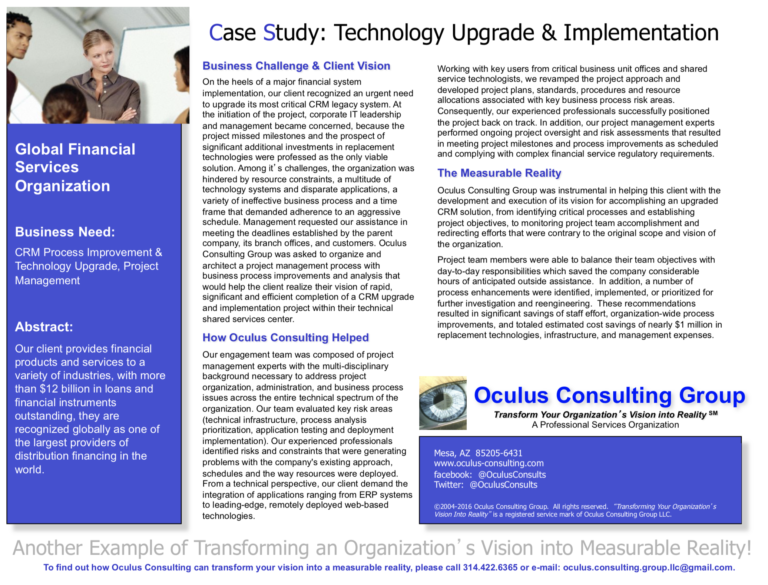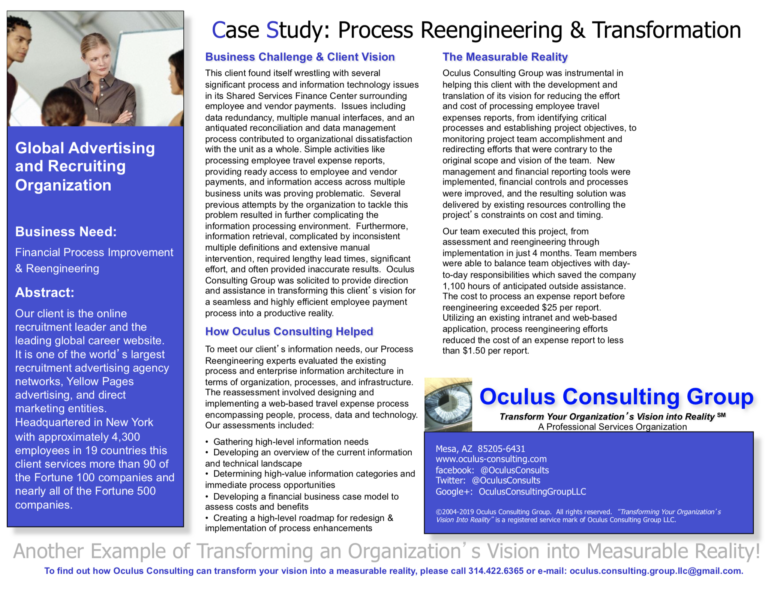Understanding the Importance of Business Process Management (Part Two)
Understanding 10 keys or principles will allow the organization’s managers and practitioners to better understand and make decisions regarding the tough decisions and debates that will naturally occur as the organization considers new technology solutions.

By Oculus Consulting Group LLC
Many organizations enamored with today’s technology infatuations have gone on an acquisition binge, thinking that their business process concerns can be satisfied with the newest version of today’s latest and greatest technologies. Today’s organizations are facing a myriad of societal, technical, environmental, economic, and political pressures in their persistent attempts to not only survive, but also to thrive. In Part One of our opinion research on Business Process Management, we outlined the important role that business processes play in organizational transformation. We looked at the role of business process management in relationship to knowledge management within the organization. In Part Two of our opinion research we’ll look at the role of business rules and business management in process reengineering efforts and outline 10 keys to effective business process management.
As technology forces organizations to require more integrity of business process execution across their business units and operations, it also requires that organizations have integrity of rules within and across the business processes, or relationships with their key stakeholders will ultimately suffer.
Business rule management is the management tool that captures, reconciles, publishes, and makes an organization aware of the entity’s business rules. The goal of this management process is an independent activity that shortens the time and effort required from identifying the need to change a rule or process to making a new rule or enhanced process accessible to all of the process enablers. At Oculus Consulting Group LLC, we understand the importance of business rule management in designing and implementing organizational transformation. We have developed and delivered workshop solutions that help our client organizations identify the critical business rules within their organization, and how they integrate into the overall organization’s vision for business process transformation.
“Each step in the process reengineering initiative will require a strong ability to focus on the work at hand with the confidence that the organization will get to together as the process proceeds.”
10 Keys of Business Process Change Management
Every business process is comprised of business rules and knowledge resources must be identified and honored to deliver business results to customers, key stakeholders, and satisfy the goals of the organization. These rules and resources are integral to the methods of business operation and change. Understanding 10 keys or principles will allow the organization’s managers and practitioners to better understand and make decisions regarding the tough decisions and debates that will naturally occur as the organization considers new technology solutions. Without adhering to these 10 keys, our experience has been that process reengineering and technology solution teams are easily distracted and diverted from the real objective of the effort – successful organizational transformation. At Oculus Consulting Group LLC, our experiences with clients both large and small have identified 10 keys to this process management activity that are essential for success. Rather than prioritize or rank the keys in an inferred order of priority, we provide the list as all-inclusive. Every organization is different and some of these keys will be more important than others for your organization. We have developed and delivered workshop solutions that help organizations identify the critical business processes within their organization, and how they integrate into the overall organization’s vision for transformation.





Key: Business Process Change Must Be Performance Driven
All process changes must be based on identified business performance measurement. Everything the organization does should be done for a reason, and process measurement is the tool that allows the organization to know if it is acting consistently within that reason for the process. One of the first mistakes organizations make is that there is a belief that someone else can tell the organization what the right measurement indicators should be. Every industry is different, and every organization has its strategies for which a multitude of performance metrics and indicators are possible.
Evident throughout all process reengineering efforts is the adage “You will get what you measure”. Every organization must know their purpose and goal and set a scorecard that is meaningful to their organization to evaluate how well they are doing. Performance measures of business processes must include all major components of success, not just financial, satisfaction, or the perceived bottom line. All organizations regardless of their size, shape, age, or mission can find the set of performance metrics from which all process decisions can be linked together to tell a complete picture of organizational performance.
Key: Business Process Change Must be Stakeholder Based
A stakeholder is anyone or any business unit that is affected by, or has a vested interest in, or can influence the organization’s business process performance in some way. Some stakeholders are more important than others and this importance will change over time. By incorporating stakeholder analysis and understanding into the process change process, their needs and expectations are the prime drivers of the performance measurements and also help to determine what those measures should be. In most organizations, one level of stakeholder analysis is insufficient, especially when considering what the various parts of the organization do and whom they deal with. Organizations that see themselves as built for the long-haul will have a completely different perspective from those that plan to take advantage of an intellectual advantage or capability in the short term. The organization must identify a set of process change and reengineering criteria based upon balancing external process stakeholders’ needs and expectations that can be measured to both make decisions now and prioritize future actions later.
Key: Business Process Change Decisions Must be Traceable to Stakeholder Criteria
Personal preferences and political agendas more often than not form the basis for new technology proposals, recommendations, and courses of actions than decisions that are derived from reality of increased value to stakeholders. Conflicting personal preferences, prior technological allegiances, political requirements, or organizational alliances among decision makers can be the critical deterrent to a successful decision-making process.
When the drivers for process change decisions are misaligned to the organization’s mission, vision, values and stakeholder expectations, it is difficult for any process change decision to optimize results that will produce a positive measurable reality for the organization. In selecting design options for every aspect of the business process management change, stakeholder criteria must be considered. When making process scoping decisions, in selecting among business process alternatives in business cases, in allocating valuable resources (both people and technology) to work requirements and in communication and human change management, stakeholder criteria is essential to an effective business process change process.
Key: Business Units Must Match Business Processes to Synchronize Change
It is a natural management perspective to view business processes as the primary segmentation strategy internal to, and among, organizations. As today’s technological enhancements and opportunities shrink the business cycles of products and services, management structures within the organization are often slow to respond. Organizational boundaries and planning mechanisms often do not anticipate changes well enough to be market leaders.
Only within the organization change will business process change stake the claim of achieving enterprise-wide integration and organizational transformation. By definition, a process starts with the first triggering event that initiates action and ends when the results of value are delivered to the appropriate stakeholders. All other organizational structures should be put in place solely to serve this event-to-outcome process for delivering value to stakeholders. By segmenting the business organization along process-value added lines of operation, a clear framework for organizing and prioritizing change and measuring the impact of business process improvement efforts can be achieved and understood.
Key: Business Process Change Must Be Managed Holistically
The critical mechanism that must be in place within the organization for effective ongoing process change and management to be effective allows for processes to be discussed amongst the organizations managers and leadership. Typically, senior managers and business unit leaders not only have a line, but also have at least one process to report against and act on. Unit evaluations based upon process change recommendations must take reporting and follow-up seriously. Organizational leadership must also be decisive about the consequences of not supporting the change approach. Business unit staff involved in the day-to-day execution of the process must also see feedback on the ultimate results of the process. Incentives for change and performance enhancement must support overall stakeholder creation and not simply what is convenient for individual process participants.
Key: Process Change Initiatives Must Inspire Shared Insight
Business process reengineering relies heavily on gathering information, mapping existing and desired improvements, gaining understanding, and arriving at innovative approaches for measurable implementation and improvement. As the organizational focus of business process change expands, a business will require more formal approaches to identify, connect, and share what’s known as well as to realize the identifies and trustworthiness of the knowledge experts in the process.
In performing this analysis, it is important to be cautious about placing too much emphasis on the process change model being used. These models are only one component of the overall process reengineering deliverable. Arrival at a common understanding of the situation and the potential for improvement by the entire organization is essential to successful improvement.
Key: Business Process Reengineering Must Be Conducted From The Outside In
When conducting business process reengineering initiatives, it can be easy to become overwhelmed with the daunting task of mapping all the details associated with the business process. As a result, “analysis paralysis” can ensue when the timeframe is limited or the number of knowledge experts is reduced. Each step in the process reengineering initiative will require a strong ability to focus on the work at hand with the confidence that the organization will get to together as the process proceeds. The team performing the analysis and design should focus on maintaining the appropriate level of detail. Avoid spending unnecessary time analyzing work that won’t exist until later. Focus on the key aspects, and not all the aspects. Understand the drivers and identify the insights needed before moving on in the process analysis. Context will provide meaning at every level of detail or decomposition. Details will come when they are needed.
Key: Process Reengineering Must Be Iterative
It is imperative to acknowledge that your organization’s human resources don’t have all the answers in advance and they must create an environment where they can engage sufficiently to figure things out and articulate them incrementally. This iterative approach can be found in a variety of knowledge creation processes, in prototyping of technology processes, and scientific research oriented activities. Be prepared to accept that you will likely get it wrong, before you get it right and that the organization will be required to try the change in a variety of environments before you select the final process decision as practice. Utilizing a time-box scenario in the process reengineering effort will help ensure that the reengineering team will not get too deep too soon, too far off track without an opportunity for correction, and most importantly, will ensure the gradual commitment and acceptance of deliverables that will be essential from all participants.
Perfectionists will have a difficult time with this approach. The process reengineering effort will require good listeners, who can develop trust and respect, and good presenters who will explain but never defend their process findings. Team participants must be comfortable in revealing their incomplete, incorrect work products and see any enhancements to them as a positive contribution to the process. Likewise, team members who dominate or push for their predetermined technology solutions are inappropriate for this work.
Key: Business Process Reengineering Is About People
Many of the steps traditionally thought of as “essential” in managing business process reengineering is eventually proven to be there for no good reason except to substantiate decision support by executives. Often business process management activities are emphasized ways of creating a document or specification for a technology solution. Organizations must see the outputs of these process change efforts as not just converting technology, or data, or procedures, or organizations; they are essential tools in converting people into enthusiastic supporters and participants. You must support change initiatives with appropriate roles and responsibilities, organizational structures, empowerment with accountability, aligned performance incentives, and recognition as well as career growth opportunities for participants. The organization’s human resources must feel appropriate levels of trustworthy communication are occurring. Ensuring a sense of positive contribution is essential.
Key: Business Process Reengineering And Change Management Is a Journey
Most organizations would agree that in today’s hyper-paced environment that they don’t have time to get it right, so whatever they do will have to be subject to adjustment as the organization learns from the marketplace. And, no matter what the organization does and how right it might be, it will be short-lived and ultimately be subject to change soon. Current market conditions and technological advancements mean that process must be managed, even when they aren’t undergoing radical change. Without proper business process management and ownership, ongoing measurement, appropriate benchmarking, and constant attention to stakeholders across the organizational spectrum, the organization is bound to fall behind through simple attrition.
Doing something small now and learning are more valuable than getting a bigger process more perfect later. Building learning feedback and knowledge distribution into business process reengineering activities is mandatory. Designing for change is essential. Acting fast in a highly technologically disruptive environment is not a risky strategy if the organization is adequately prepared to pay attention to the process change outcomes and can adjust accordingly.
Concluding Thoughts
By defining and describing the main concepts of business process reengineering, business process change, and process management, these key principles can assist the organization in addressing risk factors as part of any transformation design. If the risk factors are ignored, the change of organizational success will be reduced, and the process reengineering effort could ultimately be detrimental to the entire organization.
At Oculus Consulting Group LLC, we understand that these key principles can mean the difference between successful responses to disruptive technologies, dynamic market changes, and the need for substantial organization transformation. Our demonstrated achievements in assisting our clients transform their vision for business process reengineering effectiveness into a measurable reality of enhanced organization performance can assist your organization as you proceed with similar efforts.
To learn how you can secure our services and assistance, please contact us.
© 2018-2021 Oculus Consulting Group LLC
Oculus Consulting Group LLC and “Transform Your Organization’s Vision into a Measurable Reality are registered service marks of Oculus Consulting Group LLC.
